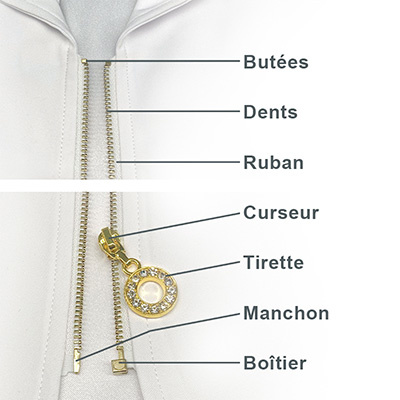The Best Tips for Maintaining Your Zippers !
Resist the Wear of Time: Tips to Prolong the Lifespan of Your Zippers
Are you tired of zippers always failing at the most inconvenient times? Don't worry, there are tricks to extend their lifespan! Follow our advice and say goodbye to snags and tears.
What is a zipper?
Ah, the zipper! This practical and indispensable accessory for our clothes. But what exactly is it? Well, the zipper, also called a slide fastener or zip, is a closure system that allows for quick and easy opening and closing of a piece of fabric. It consists of two strips of fabric or plastic, with small metal or plastic teeth that interlock when the slider is pulled. Available in many sizes, colors, and styles, it can be sewn onto a wide variety of fabrics, from knitwear to cotton. However, to make it last over time, it is important to maintain it properly.
* A little extra for your general knowledge * :
The zipper system was invented by the Swedish engineer Gideon Sundback in 1913.
The name "zipper" comes from how it operates. The teeth of the zipper slide into each other, making a sound similar to that of lightning escaping from a storm. The term "zip" is used here to describe the speed and smoothness with which the two parts of the zipper come together. In French, the term "zip" is also used to refer to a zipper, borrowed from the English "zipper." This word comes from the sound a slider makes when it is opened or closed.
The zipper is widely used today in the making of clothing, bags, and other accessories. It allows for quick, convenient, and efficient opening and closing of the products it equips.
Here are the components of a zipper:

- Box: This metal or plastic part is attached to one of the two edges of the opening and contains the zipper teeth.
- Sleeve: This metal or plastic part is attached to the other edge of the opening and serves to guide the slider.
- Slider: This small button is used to open and close the garment. It is moved using a zipper pull, which is often decorative as well.
- Teeth: The teeth are metal or plastic elements attached to the tape that the slider interlocks to keep the opening closed.
- Stopper: This small piece of metal or plastic is located at the end of the zipper and prevents the slider from sliding off the tape.
The benefits of a well-maintained zipper
Those famous "zips," those little accessories that make our daily lives easier, but can sometimes cause us a lot of trouble. However, with regular maintenance, zippers can last for years without losing their effectiveness. And the benefits are numerous! By taking care of your zippers, you will avoid problems such as jamming, breaking, or zipper that won't hold. Moreover, a well-maintained zipper will allow you to continue wearing your favorite clothes without having to replace them.
How to keep a zipper in good condition?
To preserve and extend the lifespan of your zippers, it is essential to maintain them carefully. Make sure to clean them regularly with a damp cloth or using appropriate methods depending on the material of the zipper. Don't forget to lubricate them with suitable products to ensure their proper functioning. Finally, be mindful not to exert too much force when using them to avoid deformation.
Simple tips to facilitate the operation of zippers
Now onto our tips and advice;
Have you ever been stuck in front of a stubborn zipper? Don't panic, there are simple tricks to facilitate the operation of these sewing wonders.
First of all, if the operation is difficult, try applying a little dry soap or candle wax (a cake candle will do) on the front and back surfaces of the elements, then move the slider up and down to regain smooth operation. This will lubricate the zipper mechanism and make it easier to handle. If this doesn't work, you can also try running a cotton or nylon thread through the teeth, making sure not to force it. This technique helps to realign the teeth and facilitate their sliding.
If the fabric gets stuck and hinders its operation. Move the slider slowly while pulling on the stuck fabric. Please leave enough space for the slider to move smoothly when closing the zipper on the fabric.
Next, it is necessary to have an appropriate washing procedure to preserve your zipper properly. Make sure to fully close all zippers when using washing and drying machines. Incompletely closed zippers can get tangled with other items and cause damage to the teeth, slider, or fabric of other items. Long or thin sliding pulls can get caught in the holes of your washer or dryer drum causing breakage, so it is recommended to remove removable pulls or use a laundry bag for these items. After drying, do not use the zipper until the garment temperature returns to normal, especially if it is made of plastic.
By following these tips, you'll be ready to face any stubborn zipper with confidence.
Resistance to the wear of time begins with careful maintenance of zippers !
And there you have it, we've come to the end of our article on resisting the wear of time on your zippers! You've understood that to prolong the lifespan of your favorite sewing accessories, it is essential to take care of them and maintain them meticulously. Whether you love sewing, embroidering, knitting, or simply wearing clothes with zippers, remember that these little bits of zipper deserve all your attention. So, remember: resisting the wear of time begins with careful maintenance of zippers!
You'll see, it's really worth it !






